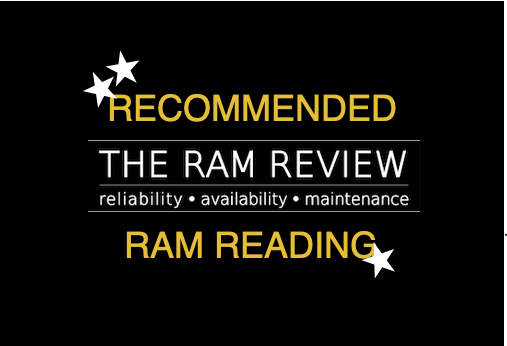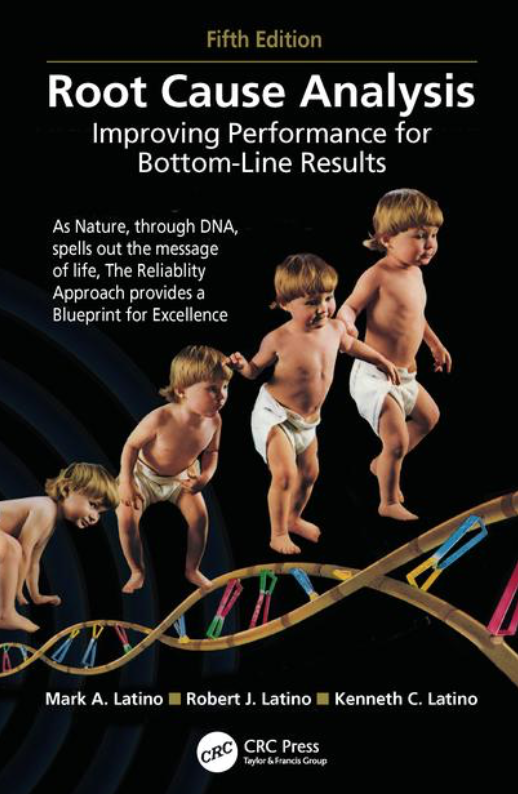ISBN-13:978-1138332454
GUEST REVIEWER:
Sanya Mathura
Strategic Reliability Solutions.
It was an absolute pleasure to read Root Cause Analysis; Improving Performance for Bottom Line Results, 5th Edition, by Mark Latino, Bob Latino, and Kenneth Latino (CRC Press, July 2019. Boca Raton, FL).
My brain was taken on a journey about the foundations of reliability, its implementation (at a time when it was an unheard of experience), and a greater appreciation of Root Cause Analysis (RCA). It was quite an experience.
The book starts with a tribute to the grand maestro himself, Mr. Charles Latino, and takes the reader through situations that some of his colleagues had to experience when he asked them to become part of his reliability team.
Being the visionary Mr. Latino was, his ideas about reliability began in the 1960s, and he has been dubbed, “the Father of Manufacturing Reliability.”
It is quite mind-boggling to read about the experiences that the original Allied Chemical team had to face some 50 years ago, as they ventured out into the great unknown area of reliability. They met great difficulties in trying to convince persons that the reliability journey would ultimately help the company become more efficient. It was even more mind-boggling to realize that there are some industries where this type of thinking and decision- making about ignoring reliability still exist in this century.
After these acknowledgments, it’s as though you walk through another door into a room and sit on a sofa with the Latinos for a very engaging chat about RCA.
The style in which the book is written allows the reader to understand at the most basic level what RCA is really about. The authors begin laying the foundation for a simplified Asset Performance Management framework, which includes MTBF, Balanced Scorecards (the full package!), and then relate it to where RCA fits in this grand schematic. This is absolutely critical for all reliability engineers (and readers) to understand the role and impacts that RCA can have in the organization. Having these foundations explained in this manner is a great treasure for readers.
The Latinos provide an almost-forensic examination of the term Root Cause Analysis, its origins, and various methods (inclusive of 5 Why, Fish Bone and Logic Tree). The pros and cons of each of the methods are discussed in great detail, which allows the reader to become fully aware of each of the tools and the most appropriate instances in which they can be used. Brainstorming methods such as the Swiss Cheese model and differences between Six Sigma and RCA are also identified and fully thrashed out.
After reading some of these chapters, the reader really begins to question the context in which these terms have been used or misused in the past. The delicate manner in which these comparisons were done allows readers to form their own opinions with their very own brainstorming sessions.
As most analysts know, before an RCA can begin, we must establish a team. Your final analysis is only as good as the work that the team put into it. Therefore, it is crucial that one understands how to choose a team and assign the most relevant roles. The Latinos extensively describe the roles of each of the team members and ways in which management can get involved as well. This is absolutely perfect when pitching to the executives to help them understand the purpose of an RCA and its impacts on the organization.
To ensure that the concept of RCA has been fully understood, the Latinos take it a step further and get the audience to identify and recognize various failure patterns. This was a great treat, as the knowledge expended in this section is not commonly found and can only be gained through years of extensive research and field experience.
Actual case studies of past RCAs help the readers to understand the approach that one should take when performing an RCA. The reader is exposed to a guided, methodical path of thinking which obtains the facts about an incident and leave no room for opinions! An RCA must be factual!
One of the most interesting chapters in the book covered the understanding of human behaviour. Human error is usually the top suspect when an RCA begins. However, the Latinos have managed to capture the causes of most human errors on the worksite and translate these into latent root causes which we can address. Essentially, this chapter of the book is a supervisor’s guide to understanding the reasons behind human errors that occur in the workplace and methods that can be implemented to avoid such incidents. It is an absolute must-read chapter for anyone in management.
The book ends with case studies in which RCAs have been performed around the globe. This provides an ideal knowledge base for readers to put their newly acquired RCA skills into practice. The readers can follow along the paths that the analysts would have taken in performing the RCA and they can also discover the actual root causes for very relatable case studies.
Overall, Root Cause Analysis; Improving Performance for Bottom Line Results, 5th Edition is a book to keep handy, as it is packed with information not only about RCAs, but formulae on MTBF, derivations of reliability, and definitions on reliability from all aspects. The famous PF curve is also included.TRR
EDITOR’s NOTE: This book is available through CRC Press and on Amazon.
ABOUT THE REVIEWER
Sanya Mathura is Founder and CEO of Strategic Reliability Solutions Ltd., based in Trinidad & Tobago. Email: strategic.reliability.solns@gmail.com




